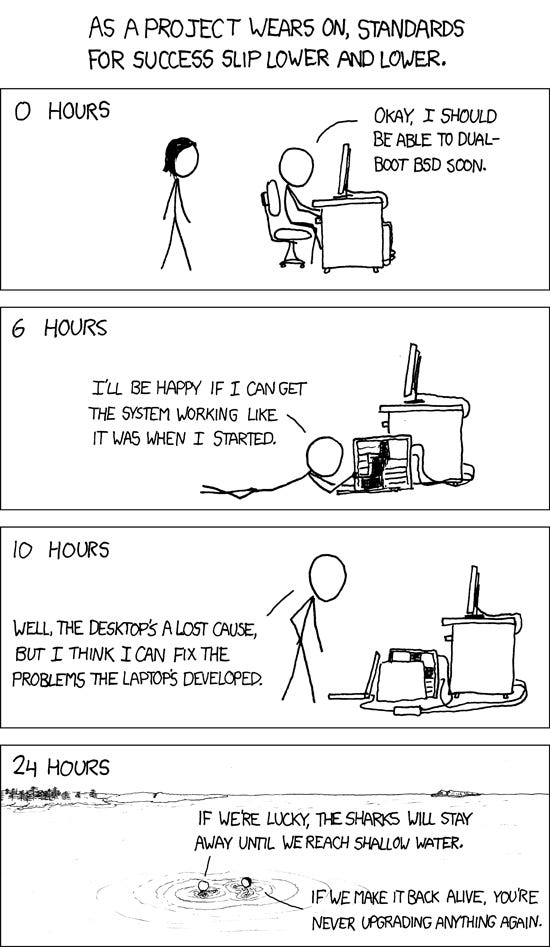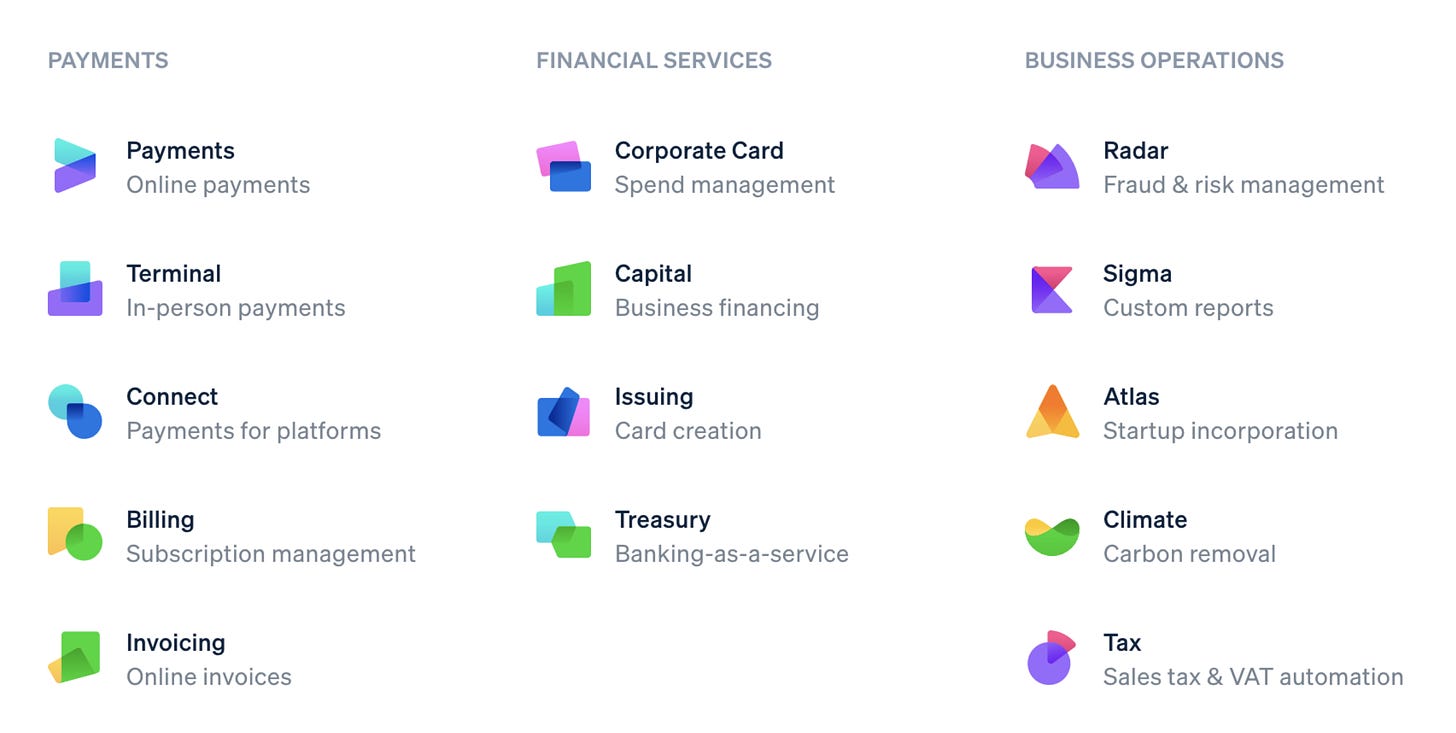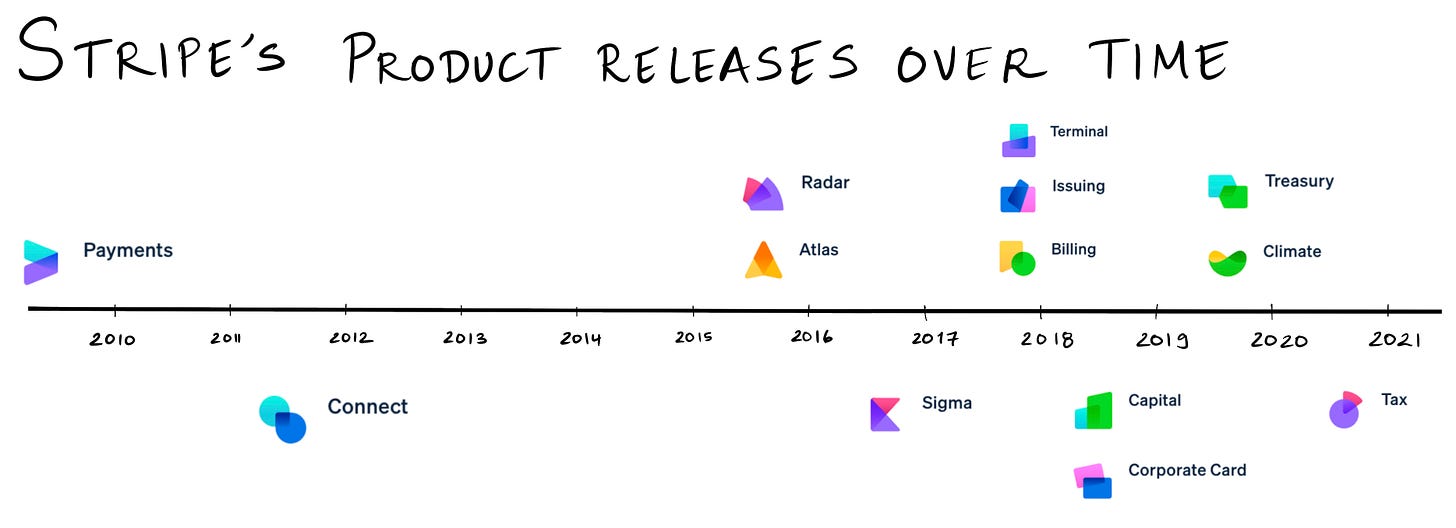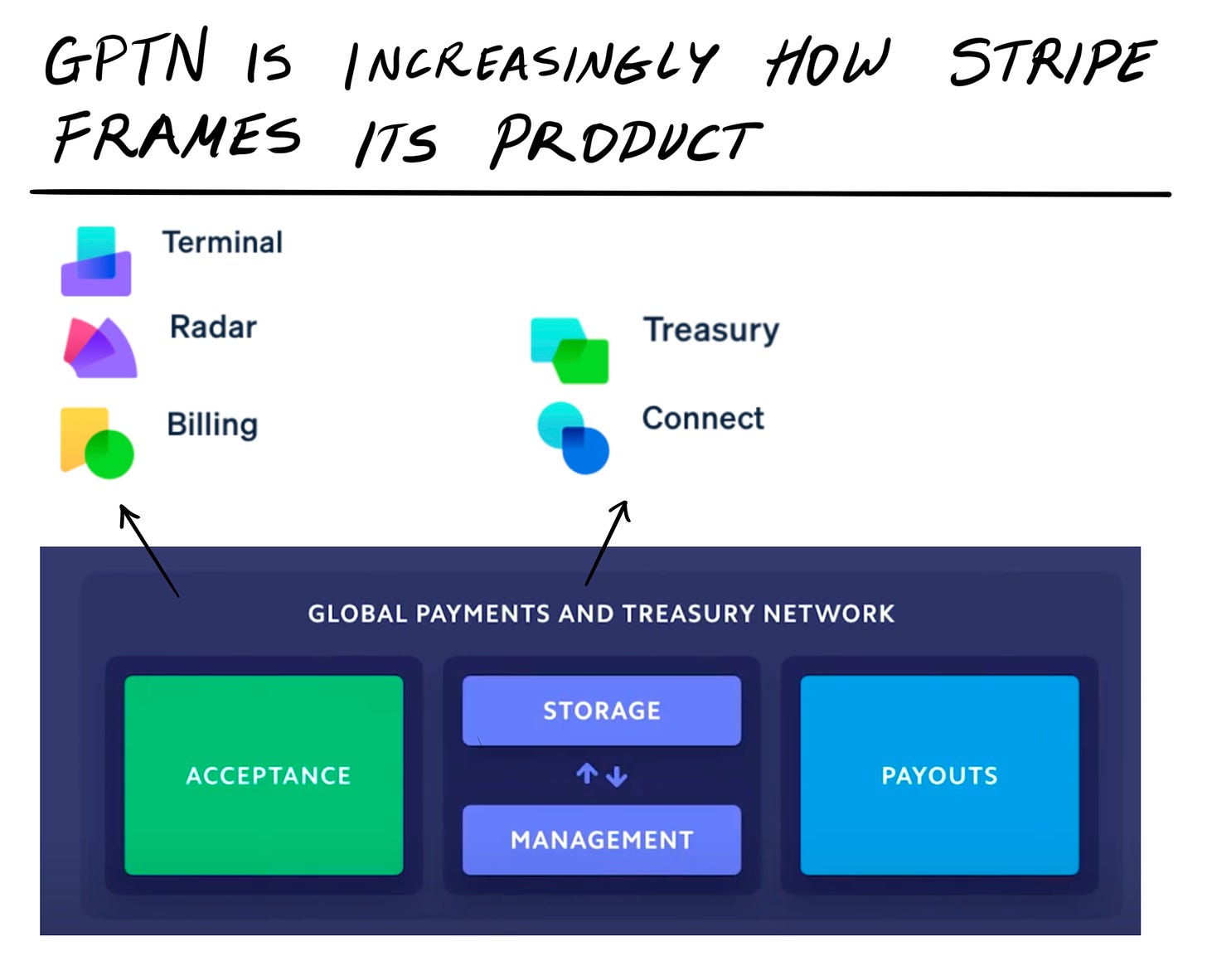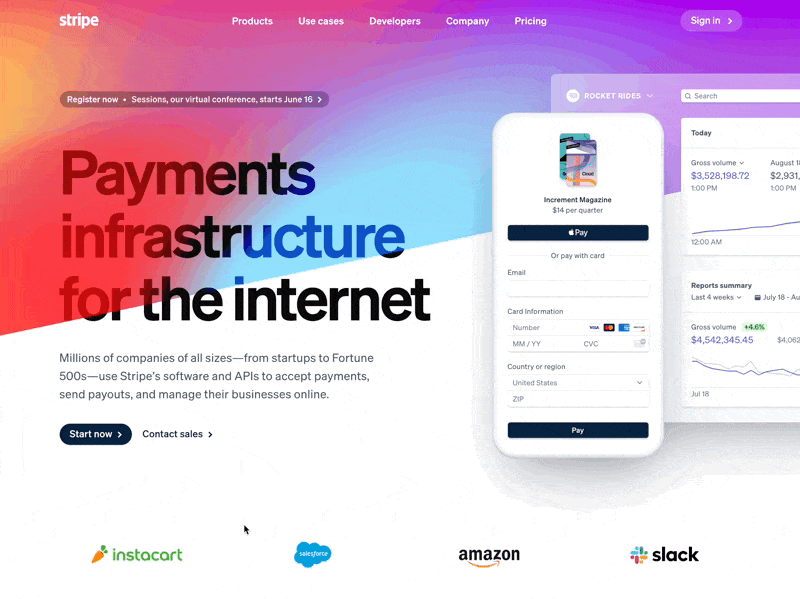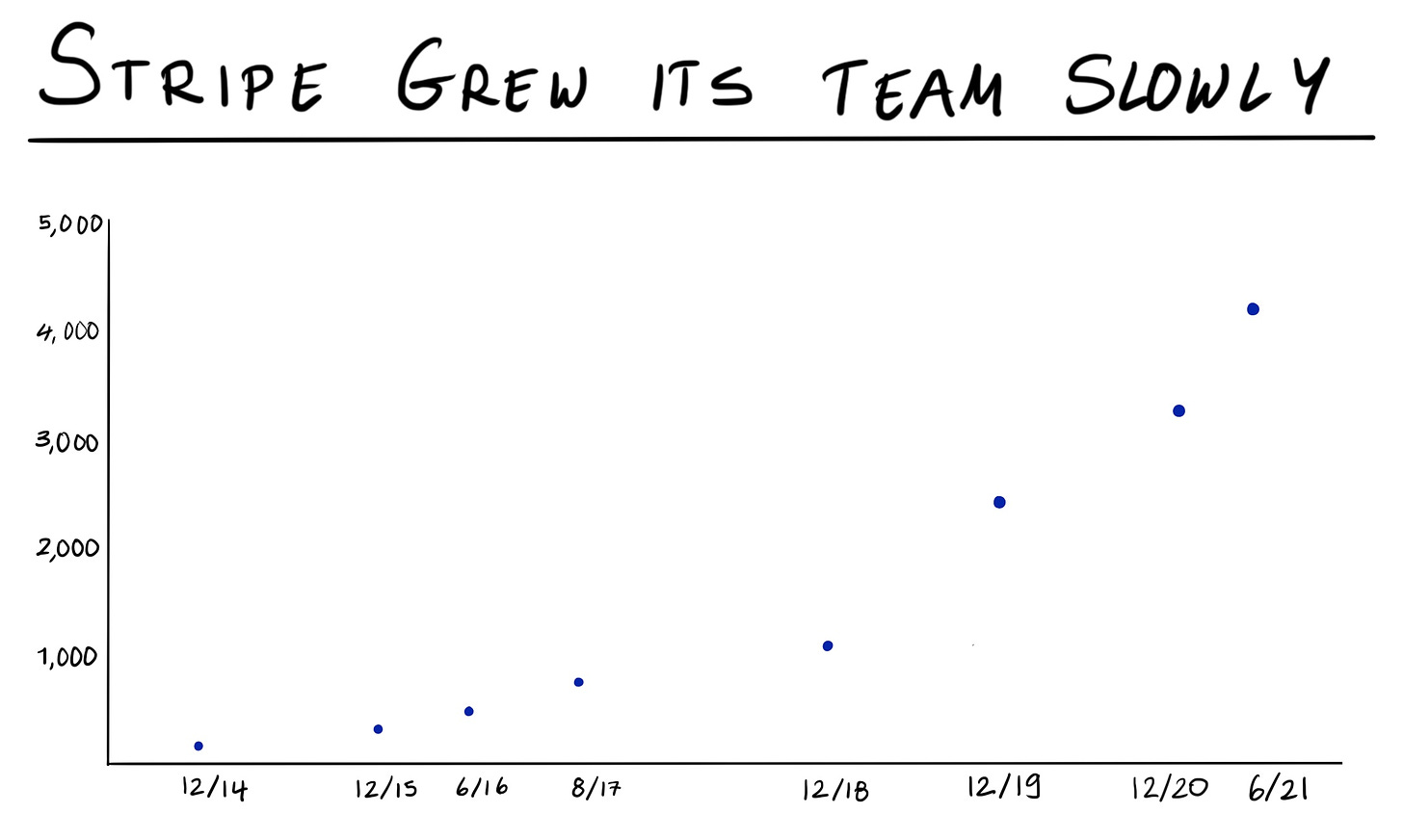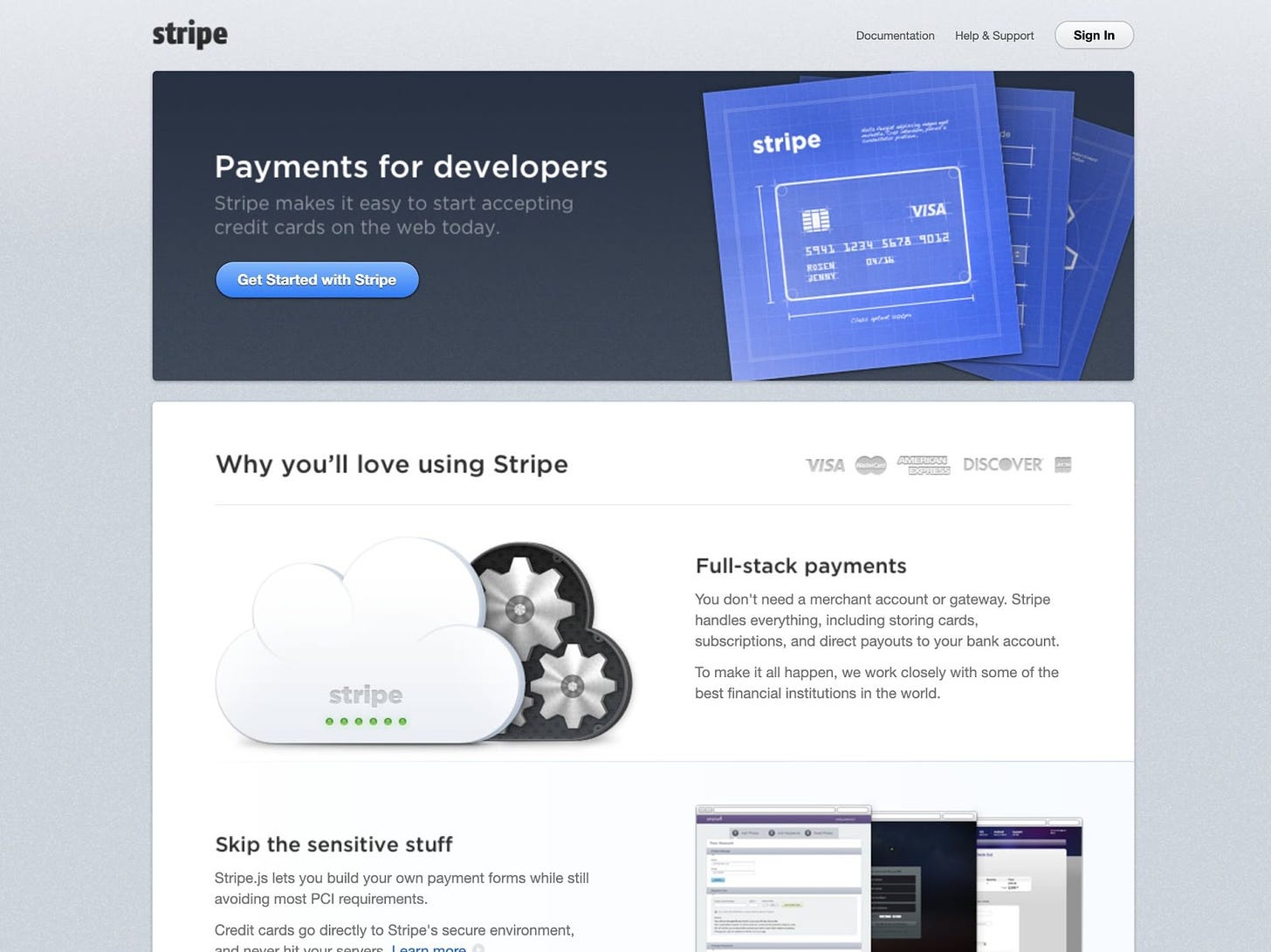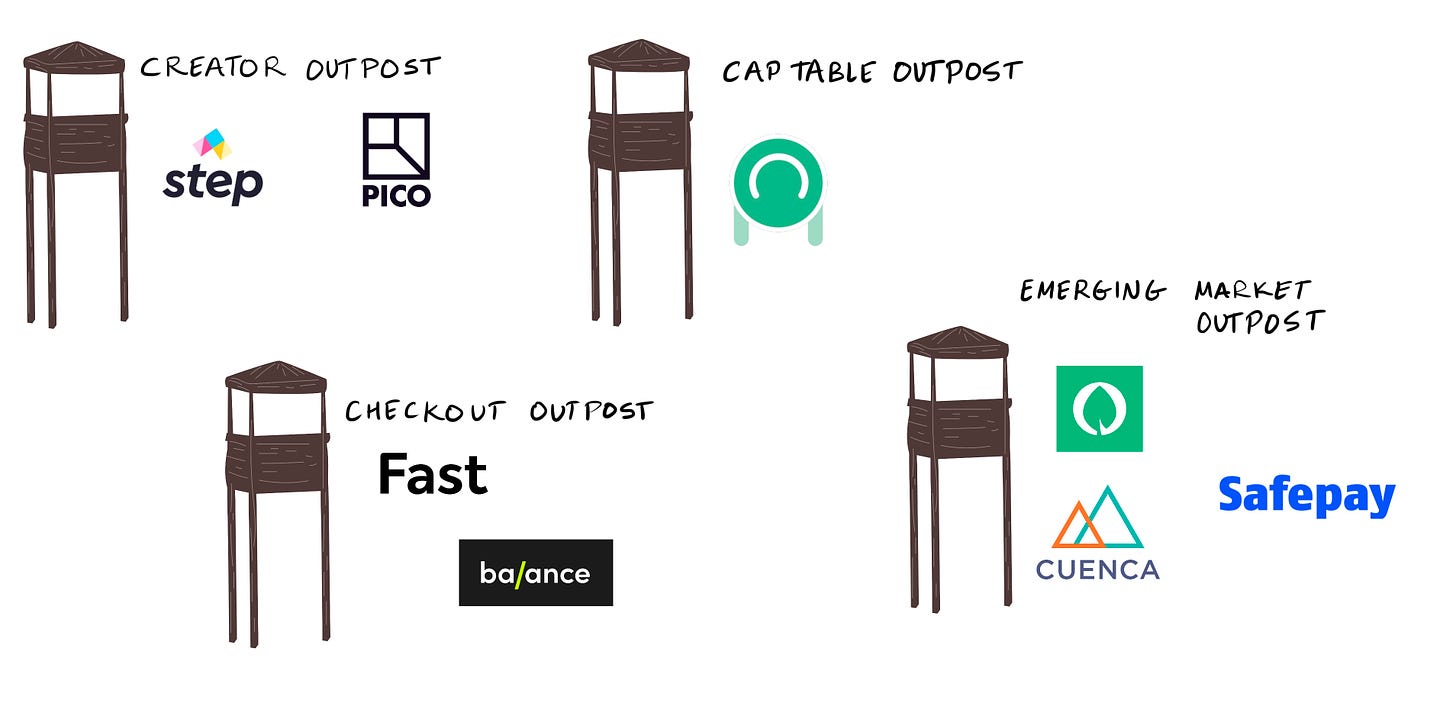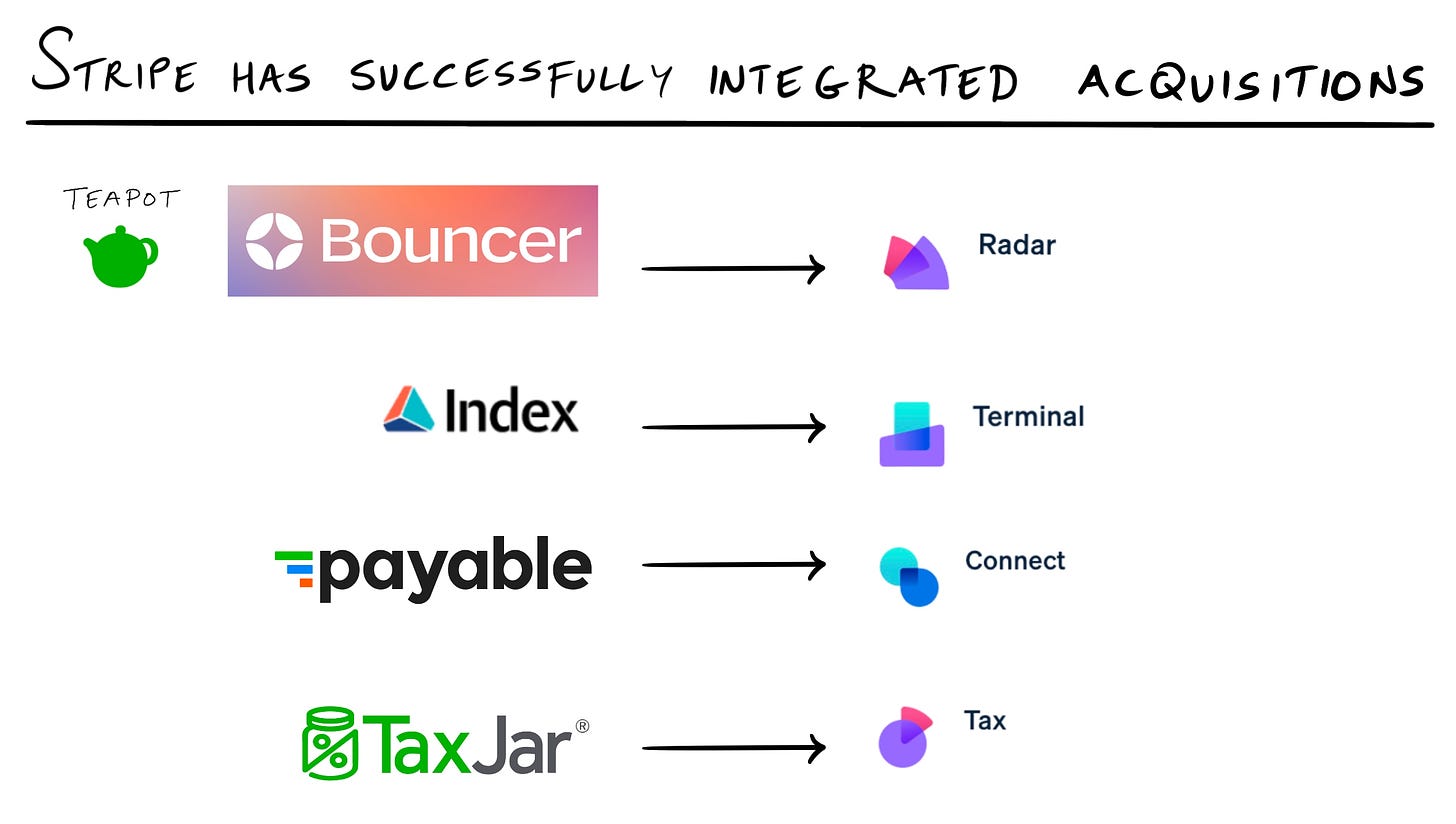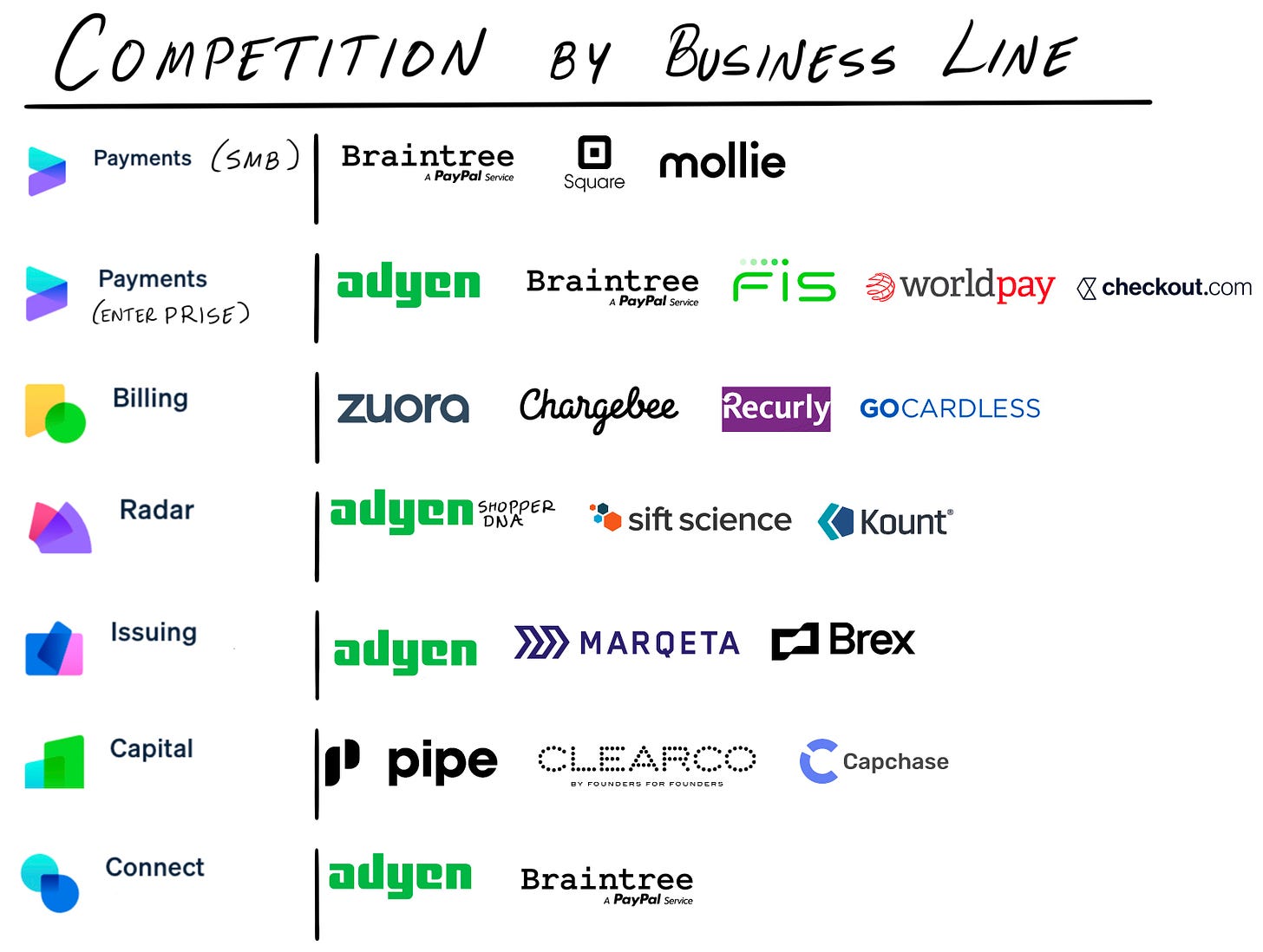Stripe: Thinking Like a Civilization
The payments company's cultural power may be its most remarkable trait.
What if Romulus and Remus had gotten along?
As the story goes, after creating their first settlement, Rome’s wolf-weaned founders fell out over the right hill upon which to build their city. While Remus liked the Aventine, Romulus preferred the Palantine.
Romulus exercised the most final method of winning an argument, killing Remus. In the aftermath, the surviving brother built an empire that indelibly altered the world, spanning hundreds of years.
As founding stories go, Romulus’s advances a rather consequentialist morality — can we really be too upset over one teensy-tiny murder balanced against the great technological and cultural gifts Rome wrought?
But there’s an alluring counterfactual to the legend. What would Rome have looked like had it not been forged from brutal fratricide? (And a rather petty fratricide at that, like kicking a co-worker down the stairs for stealing your standing desk.) If Romulus and Remus had navigated a more peaceful path — perhaps they needed a founder’s coach; ubi est Giro Colonnus? — what would Rome have looked like? Could we have had the progress without the gleeful savagery? Bread without the circus? A little more Marcus Aurelius, a little less Caligula?
In Patrick and John Collison, Stripe has two framers thinking at a civilization-level. This is rare, even among tech’s boldest executives. With the exception of Musk, Bezos, and Buterin, no founder is constructing an empire with quite the same thousand-year stare or detailed, architectural love as the Siblings Stripe. (Even Zuckerberg, lover of Augustus Caesar, is perhaps too absorbed with accumulating personal power to qualify).
More than anything else it is this horizonal focus that defines Stripe, guiding its remarkable recruitment, celebrated culture, and sophisticated product strategy. That is not to declare the company an enduring success yet. Though Stripe feels like a generational company in the making, the business is only at the beginning of its second decade, the equivalent of a rounding error in the context of the organizations the Collisons observe most closely. And while Stripe’s mission to “increase the GDP of the Internet” is impelled by powerful global tailwinds, the company is also arguably overvalued, beset by real competition, and attempting a delicate balancing act between serving SMBs and enterprises. That may all prove too much.
In today’s briefing, we’ll delve into every facet of the company (and inevitably leave much unsaid) with particular reference to:
Patrick and John’s origins
Stripe’s early days
Product as offense and defense
Patient recruitment, cultural touchstones, and soft power
M&A and Stripe’s coy venture arm
Competition and where Stripe may lose
The next 10 years
Every Sunday, we send a free email that explains the business world’s most important innovations and the stories behind them. It’s high quality business analysis, delivered at no cost to you.
Origins: Permissionless Entrepreneurship
We never quite see the milieu in which we are raised. The particular dales, quirks, and landmarks of our hometown blur into a familiarity close to blindness. If they chose to, the Collisons would notice they grew up in the shadow of a monument to empire and its decay.
Early days
Dromineer is a sleepy town in County Tipperary, about a forty-minute drive from Limerick. It is best-known for a beautiful lake and the overgrown ruins of a 13th-century tower house built by a relatively short-lived medieval dynasty.
If that is a rather elliptical allusion to Collison’s destiny, a recent revelation makes a direct link. In April of this year, Patrick tweeted his discovery that one of the authors of a computer science book entitled Electronic Payments Systems for E-Commerce once lived in the brother’s childhood home.
Which is to say fate has a good sense of humor, and every good mythology becomes richer post-hoc.
As you might expect, both Patrick and John showed precocious gifts. As sons of an electrical engineer and microbiologist, the Collisons showed an aptitude for scientific and technical pursuits. Computers played a significant role in their intellectual exploration, with the Collison home hosting nine of them hooked to speedy satellite internet by the time Patrick and John reached their teenage years.
At the age of 16, Patrick earned recognition for his technical abilities, winning Ireland’s annual science competition for his work on “Croma,” a dialect of the Lisp programming language. Patrick’s interest in the world’s second-oldest programming language (FORTRAN edges it out by a year) proved influential, both in his choice of university and in forging a relationship with a powerful mentor.
In 2006, using an SAT score from a test he’d taken at the age of 13 (an infuriating anecdote), Patrick matriculated to Lisp’s birthplace: the Massachusetts Institute of Technology. He’d sped through the final two years of his high school curriculum in just twenty days.
Shuppa and Auctomactic
John was not far behind. A little under two years younger than Patrick, he’d also excelled at school, leaving with a straight sweep of A1s, one of just 11 students in the country. But we are getting ahead of ourselves. Before John even finished school, he joined Patrick in Boston using the “Transition Year” allowed by the Irish schooling system to voyage Stateside as a 16-year-old.
In 2007, the brothers founded “Shuppa,” a play on the Irish word “siopa” for shop. The Collisons’ plan to build a direct eBay competitor received little interest from Ireland’s entrepreneurial development initiative but did receive backing from Y Combinator. The incubator was famously founded by Lisp grandmaster, Paul Graham.
At the incubator, the Collisons were encouraged to join forces with another precocious duo, united by family bonds. Recent Oxford graduates, Kulveer and Harjeet Taggar had seen reasonable success with their first endeavor, “boso'' which stood for “Buy online, Sell online.” Their next act was to found Auctomactic, a platform designed to serve eBay power-sellers. Though a divergence from their initial idea, the Collisons joined.
That proved a savvy decision. Less than a year after its founding, Auctomatic was the subject of a bidding war, seduced by three parties. In the end, Live Current Media, an owner of premium domain names like Communicate.com and Brazil.com, won out paying $5 million for the business. Patrick and John became young millionaires, a categorization that won them considerable press, particularly back home.
Though the outcome is impressive so much as teenage, self-made millionaires are outliers (even within tech’s paradigm of youth worship), the effort, the process is more so. Even great founders take years to internalize the fact that entrepreneurship is permissionless, an open door that anyone, no matter how junior, can walk through, and that no shame will (or should) cling or mark those that venture and fail. The ease with which the Collisons intuited this indicates a precocity of wisdom even more impressive than their prodigious intellect.
That unusual, almost casual audacity would prove essential in their next act.
/dev/payments
While that might have prompted some to sit back and bankroll a boozy jaunt through university, the Collisons barely seem to have caught their breath. After the sale of Auctomactic, they financed their studies — John having now matriculated to Harvard — by building mobile apps. It was in earning money through this relatively seamless method that the brothers realized what a mess processing payments was elsewhere on the internet.
Almost a decade after PayPal had entered the space in 1998 and ostensibly “solved” the problem, the state of play remained byzantine and punitive, requiring considerable administrative work and holding funds for weeks at a time.
In realizing the brokenness, the Collisons overcame what Paul Graham once described as “Schlep Blindness”:
There are great startup ideas lying around unexploited right under our noses. One reason we don't see them is a phenomenon I call schlep blindness. Schlep was originally a Yiddish word but has passed into general use in the US. It means a tedious, unpleasant task…
The most striking example I know of schlep blindness is Stripe, or rather Stripe's idea. For over a decade, every hacker who'd ever had to process payments online knew how painful the experience was. Thousands of people must have known about this problem. And yet when they started startups, they decided to build recipe sites, or aggregators for local events. Why? Why work on problems few care much about and no one will pay for, when you could fix one of the most important components of the world's infrastructure? Because schlep blindness prevented people from even considering the idea of fixing payments.
In attempting to solve this “most important component,” Patrick and John took inspiration from a business that shut down just a few years later. Slicehost provided hosting services, bootstrapping to acquisition from Rackspace, before the product was sunsetted in 2011. As Patrick would note in conversation with John Lilly, the Collisons initial goal was to create “Slicehost for payments,” emulating the ease of spinning up new servers with service.
With that model in mind, Patrick and John set to work on their business, beginning in 2009. They even had a “super awesome, cool” name for it: /dev/payments.
Though tortuous in one respect, Stripe’s first sobriquet was elegant and enlightening in others. Not only did it emphasize one of the Collisons’ keenest insights — that developers, not businesspeople, would pick the payment stack of the future — its architecture hinted at endless possibilities. After all, couldn’t /dev/ prepend any number of infrastructural issues?
To kickstart the business, Patrick and John raised a $20,000+ round from previous backer, Y Combinator. Since they had gone been through the cohort recently, the Collisons elected not to join this time around, an interesting quirk given that Stripe is often billed as YC’s greatest success story. (Given the preceding relationship, and subsequent connections provided, that credit is clearly merited, though more nuanced than reasonably presumed.)
The YC network proved a particularly useful way to find first customers. Two weeks after the Collisons released an MVP, /dev/payments processed its first transaction, with Ross Boucher of 280 North the first to use the system. As Boucher remembers, the first transaction was for $40.00. Apparently, 280 North was using PayPal, but Patrick offered to write the code to switch the company over to/dev/payments.
(Boucher would go on to join the company. According to him, "I certainly didn't expect [Stripe] to become as big as it has.")
Soon, the company had roughly 30 customers from the incubator, growing further through word of mouth. As Patrick would later tell, product/market fit on /dev/payment’s first product proved almost “instant.”
Mercifully, in name, /dev/payments did not last. Though the Collisons had, characteristically, done their research to ensure corporations were allowed to use a slash in their name, they missed the fine-print: leading slashes, like those employed by /dev/payments were verboten meaning that the formal name of the company morphed into the unintelligible SLASHDEVSLASHFINANCE (another hint of broader ambitions). Though receiving mail with various combinations of those words might have qualified as reason enough for a shift, the true trouble was in communicating orally. What was the best way to articulate the moniker’s precise composition?
That name proved particularly off-putting to the stuffier bankers at Wells Fargo that Patrick and John attempted to woo. The company’s first provider had arrived via a stroke of luck — Patrick recalls meeting someone at a party with a setup in the Midwest that /dev/payments was allowed to piggyback upon.
(Given the geographical clue and sector I suspect this might have been Dwolla, but can find no proof of that. I’d love to know who it was for my own curiosity if anyone is able to share.)
While a good way to duct-tape to an MVP, it broke at scale. To fulfill transactions, Patrick and John had to fill out forms manually with the transacting customer’s information, then send them onto the financial platform.
As both Patrick and Greg Brockman, an early employee and later CTO, tell it, the slim /dev/payments team worked through a panoply of options before settling. Among the serious choices:
Stack.com. This was an under-used property owned by someone Brockman notes “went to the same school.” After reaching out the owner, quoted a multi-million price tag. Dead end. Today, it hosts a site that focuses on high school sports.
Forge.com. The whole team liked this one before a friend highlighted the rather unfortunate connotations of the word’s secondary meaning. (Think “forged documents.”) Not ideal for a payments business.
Paystack.com. Roughly ten years after considering this domain, Stripe bought a Nigerian payments processor with the same name. Either this is yet another cosmic wink aimed at the Collisons, or somewhere along the line, the name was proposed to Paystack’s founders.
Parse.com. The team received a response from the domain owner, but felt they had better options. Tikhon Bernstam later received a list of viable domains from Greg Brockman, and used the name for cloud platform.
Paydemon or Paydaemon.com. Apparently something of a front-runner, particularly because of the potential for visual adornments, including a mascot. (Both names are available for sale if you’d like to own a footnote in Stripe history.)
In the end, the team made a decision through default. Brockman declared that if a better alternative couldn’t be agreed upon within a week, /dev/payments would become Stripe. In its simplicity, allusion to a credit card’s strip, nod to lines of code, and inference of frictionless speed, it proved the perfect appellation for the company to come.
Stripe
Before scaling, Stripe would first need to solve its banking issue. Once again, a Y Combinator connection proved the ace in the hole.
At the time, Geoff Ralston (formerly the accelerator's President) had just come off the back of selling Lala Media to Apple. A sort of ur-Spotify, Lala provided access to “Web Songs” for the princely sum of just 10 cents. To make that model work, the company had brokered deals with record labels, notorious reticent collaborators. The Collisons thought that if they couldn’t find someone who knew how to sway the big banks, asking someone that had tamed a similarly fierce adversary might prove useful.
As it turned out, Ralston had done little of the BD work at Lala, relying on a former Stanford MBA, William Alvarado. If anyone was going to solve their banking issue, Ralston assured them, Billy was the guy. That recommendation wasn’t enough to get Alvarado over the line.
So developer-centric was Stripe’s culture that the Collisons found it troubling to hire someone non-technical. “But he doesn’t code,” Patrick recounted saying.
(An early indication that the Collisons set the bar high when it comes to recruiting: the “non-technical” Alvarado received a BS in Industrial Engineering, and served as VP of Product and Engineering at SEVEN Networks, before joining Stripe.)
Only after Ralston promised to reimburse Alvarado’s salary if he proved unsuitable, did Stripe formalize their offer. Within two months, Alvardo had sealed the deal with Wells Fargo.
What followed is too eventful to be adequately summarized. Since its inception in 2009, Stripe has undergone one of the most remarkable rises in the history of the tech sector. But even that feels like a slightly hollow honorific, a weak summarization of how multi-dimensional Stripe’s success has been.
Yes, the Collisons have guided the company to a $95 billion valuation, raising over $2 billion from the world’s most successful, influential capitalists.
Arguably more impressive than these metrics, however, is the dizzying array of excellent products the company has built, and the near-reverence Stripe’s name commands in tech circles. If this does prove to be the early reign of an empire, Stripe has succeeded in staking out a sprawling territory, all while engendering the sort of irenic, enveloping love tech executive’s typically save for Burning Man.
To better understand why that is the case, let us turn to Stripe’s product.
Product: Type 0 to 1
This is a yak.
Would you like to shave it?
Carlin Vieri, another MIT matriculant, coined the term “yak shaving” to refer to problems that arise in the course of trying to solve a problem. As described by fellow researcher, Jeremy Brown:
You see, yak shaving is what you are doing when you're doing some stupid, fiddly little task that bears no obvious relationship to what you're supposed to be working on, but yet a chain of twelve causal relations links what you're doing to the original meta-task.
Webcomic XKCD, a sultan of tech-related snark, outlines what “yak shaving” feels like for engineers in this piece, referenced by Patrick Collison:
According to Patrick, company engineer Avi Bryant refers to Stripe as the “greatest yak shave of all time.” In seeking to solve one problem (processing payments) dozens of others emerged; by trying to facilitate seamless online payments, Stripe revealed the need for fraud detection, card issuing, financing, and more.
After announcing “Tax” this past week, Stripe now offers 14 products, with more expected during the company’s upcoming Sessions summit.
It’s intriguing to look at these projects along a timeline:
In the discussion with John Lily referenced earlier, Patrick notes the somewhat counter-intuitive truth that companies often slow down as they scale headcount. Maintaining existing products at increased scale while onboarding, culturally inculcating, and training new members takes up considerable bandwidth, making new launches difficult.
That talk was in 2015, in the midst of Stripe’s relatively barren spell between Connect and Atlas. But as Collison said — in a manner that might be considered ominous if it were not so chipper — “When you come out of [that period], if you do it well, then stand back.”
Not quite six years on from that interview, it’s clear that Stripe has built a foundation for continued product scale. The company launched two products in its first five years; it has launched nine in the last five, with time left on the clock.
GPTN
Part of that acceleration is no doubt due to increasing coherence around what Stripe is building. Starting in 2018, Stripe began describing its suite as a Global Payments Treasury Network, or GPTN.
At the time, the phrase seemed jargony and not entirely accurate — the keynote preceded the launch of Stripe Treasury by two years. With the benefit of hindsight (and discussions with current and former employees), it’s clear this is a framework that informs Stripe’s product direction. Though less memorable than Stripe’s guiding imperative to “increase the GDP of the internet,” GPTN gets at the same point — providing universal infrastructure for a diverse range of financial interactions.
The current product suite fits well, though not completely, within this framework:
In that respect, Stripe feels almost like a fork of the Kardashev Scale. Soviet astrophysicist Nikolai Kardashev proposed a tiered model for civilization, related to energy usage. Type 1 civilizations could use and store all available energy on their planet, Type 2 civilizations could do the same across their solar system, and Type 3 could manage across their galaxy. According to Kardashev, Earth was a Type 0 civilization, yet to unlock the power of its comely blue dot.
Other thinkers forked Kardashev’s framework, with Robert Zubrin suggesting the scale could apply to “mastery” of planets and beyond, while Carl Sagan framed it in the context of the information.
Though startups describe their work as going from “0 to 1,” the meaning of that phrase when applied to Stripe and GPTN holds much greater significance. In seeking to simplify economic engagements around the world, GPTN is fundamentally looking to advance civilization from Type 0 to Type 1. We are talking about nothing less than planetary finance.
Not every product fits within GPTN, of course. Atlas, Capital, Issuing, and other business lines sit outside this central engine but play critical roles in the company’s expansion and counter-positioning.
Offense and defense
Though Patrick described GPTN as “the heart” of what Stripe is building, not everything fits within the framework. Other aspects of the company’s product stack are better seen as efforts to stake out new territories or keep adversaries at bay.
An interesting example of this is Stripe Atlas, launched in 2016. The platform makes it easy for entrepreneurs around the world to incorporate their business and get up and running with Stripe’s infrastructure (if accessible).
While Atlas supports the mission to grow the GDP of the internet, and builds admirable rapport with the founders and engineers the company serves, it has also operated as an advance guard for geographical expansion. As things stand, Stripe payments is available in 44 countries — impressive, but far from universal. Atlas, meanwhile, is available in 140. Even if Stripe can’t offer payments to entrepreneurs in Indonesia, it can still establish a relationship via Atlas, promising a degree of inbuilt demand when the country goes live. At the same time, the company ensures it doesn’t allow opponents to grow unchecked.
Though more direct, the company’s Issuing and Corporate Card products can be seen similarly. Marqeta, one of Stripe’s competitors, has used its impressive card issuing business to bolster a payments play with companies like Brex and Ramp impinging via corporate cards. By providing alternative solutions, Stripe protects its core payments business, while adding new sources of revenue and even expanding margin.
Margin expansion as mille-feuille
The first celebrity chef was, arguably, a man named Marie-Antoine Carême. Born in relative poverty and abandoned by his parents during the roils of the French Revolution, Carême rose to become a high-society darling, beloved for his daring constructions of patisserie and treatment of cooking as art. Napoleon was just one of his admirers.
Among his many accomplishments, Carême was also responsible for refining the enduring dessert, the “mille-feuille.” Meaning “a thousand layers,” the mille-feuille is a layered confection of pastry, cream, and jam. In its striated construction, it brings to mind a less sugary architecture: the margin impact of Stripe’s product suite.
Payments are a low-margin business. By adding a constellation of other products, Stripe is able to extract more basis points (BPS) from the same customer. As explained by one former employee:
There can be a case, if you are successful with these software products... you could easily see that it brings you quite a decent margin. If all of your customers use Stripe Radar, it's like another two BPS.
Many of Stripe’s products can be seen as another layer of cream on top of the payments pastry. Here are the charges different business lines levy:
Payments: 2.9% + 30c per transaction
Connect: $2 per user / 0.25% + 25¢ per payout
Atlas: $500
Radar: 5c per transaction
Sigma: 1.4c - 2c per charge / $0-$100+ per month
Billing: 0.5 - 0.8% on recurring charges
Issuing: 10c virtual card/ $3 per physical card/ 0.2% + $0.20 per transaction
Terminal: 2.7% + 5¢ per transaction
Tax: 0.4 - 0.5% per transaction
We don’t know enough about the margin profile of each of these products to say which would definitely improve margins, but viewed in totality, Stripe seems positioned to expand its net profit margins over time. As one commentator noted, “[that’s] pretty unique in a business.”
These different business lines also give Stripe a great deal of flexibility in selling. If you look at the Radar product page, for example, you’ll see this:
To encourage small customers to incorporate Radar off-the-bat, Stripe waives the fee for companies not on a custom plan. You can imagine how this applies across other lines, with wiggle-room in one area used to convert customers in another.
Detail and delight
If there’s one thing missing from the analysis of Stripe’s product above, it’s the effortlessness of the entire operation. In its very bones, Stripe is a business focused on abstracting away complexity for the end-user. It began by helping businesses accept payments with just “seven lines of code” — apocryphal according to this company post, but cromulent in spirit — and continues to thrive by simplifying financial convolutions.
To achieve that technical grace, of course, takes extraordinary effort. As Byrne Hobart noted in his rather wonderful analysis of the company, “Stripe is part of an interesting category of value-creating companies whose offering is to make some process work the way you'd imagine it worked if you had never actually tried to do it yourself.”
Stripe works. Not only that, but it does so with an elegance that can only come from obsessive devotion and exacting standards. From design to functionality, every aspect of Stripe’s suite seems to have been worried over, honed, polished. Indeed, one of Stripe’s values is to “really, really care.”
You can tell.
For goddess sake’s, Stripe’s landing page is not only achingly gorgeous — inspiration for a wave of gradient chasers — but even thoughtful enough to offer an Easter Egg.
If you go to Stripe.com and enter the old “Konami code” (↑ ↑ ↓ ↓ ← → ← → B A) here’s what you’ll see:
Visit Stripe Terminal and enter the code “4242” and here’s what happens:
(Aside: one of the iPhone apps the Collisons built pre-Stripe was an offline version of Wikipedia. John described it as the “Hitchhiker's Guide to the Galaxy,” the book from which this reference derives.)*
If users love Stripe’s product, it is — in part, at least — because the company so clearly does, too.
Sign up to learn about the next generation of disruptors. Our work exists to help you understand the businesses of the future and to capitalize on change.
Leadership: An Unusual Morality
Exitus acta probat.
The Roman poet Ovid coined that phrase, roughly translatable as “the end justifies the mean.” With that deft turn, Ovid summarized a school of moral philosophy referred to as consequentialism.
If Silicon Valley’s ethics can be distilled into a coherent ethics, this is it: do what is necessary to change the world, no matter how many toes are trampled, privacy rights violated, or human norms deranged. The method does not matter, consequentialism tells us, the result is what counts.
This is the ethos of Kalanick and Zuckerberg, and many tribute acts. It could not be further from the morality of the Collisons.
Though perhaps they would disagree, and could certainly put a finer point on their particular weltanschauung, Patrick and John seem to adhere to a deontological ethics. This school, best articulated by glorious weirdo Immanuel Kant, suggests that the morality of an action is determined independently of its outcome. Though much too simple, deontologists argue that things like intent matter.
All of which is to say that the Collisons seem to have forged an alternative for elite leadership that does not seek to excuse a noisome, polluting process with a favorable outcome. Just as Patrick notes that the “no jerks policy” companies sometimes apply to restrain themselves from hiring brilliant assholes is “too low a bar,” Stripe’s leadership seems to understand that success alone is not enough. You have to win with grace.
Perhaps it is too cynical to suggest that this, more than anything else, separates Stripe’s leadership from many startup peers. It is a team of impressive experience and tenure.
In an interview with Lattice’s Jack Altman, COO Claire Hughes-Johnson noted that she thinks of “every business like a person.” When I imagine Stripe, I picture someone unreasonably clever, confusingly humble, surprisingly funny, and untiringly active. (Hell, adverbs, I know; be damned.)
Let us turn to the three people that best define this pygmalion.
Patrick
Referring to Patrick as the “cerebral brother” feels a little like referring to Tyler as the “tall Winklevoss.” By any other standard, John is obscenely well-read and polymathic. But Patrick takes these traits to a different level.
He is an avid student of history, referring to it as a “way to cheat.” Rather than having to formulate your own brilliant ideas, Patrick explains, you can borrow from our finest ancestors. And businesspeople, of course. As one former GM noted, Patrick obsessively studied what created generational companies:
[He’d research] things like, what was Amazon doing in 1999? And what things were they doing back then that are very big now, and how many years did it take them to get there? So how should we think about our software and services?...And when, along the way, did [Amazon] feel like, "Okay, we're onto something, this makes sense or should we actually kill it?"
While this alludes to the pragmatism of Patrick’s voracious reading habit, what makes his intellect most formidable may be its breadth.
According to the same GM, a rumor circled Stripe that during a meeting with Elon Musk, Patrick disagreed with the SpaceX founder about rockets. Though the former employee wasn’t sure whether the anecdote was true or not, it almost didn’t matter — it was plausible to everyone that Patrick would not only know about rocket engines but know enough to intelligibly debate Elon Musk.
One of Patrick’s particular academic interests is “Progress Studies,” a field he hopes to advance in coordination with George Mason’s Tyler Cowen. As outlined in an Atlantic op-ed, Progress Studies seeks to “get better at knowing how to get better.” Paging through Patrick’s personal website reinforces this passion — a page entitled “Fast” lists significant accomplishments achieved quickly, “Growth” discusses how economies and institutions grow or fail to, and “Progress” delves more directly into the field noted.
This is worth mentioning because it so clearly applies to Patrick’s mission. Stripe is not just a capitalist enterprise, but an endeavor to drive humanity forward.
Patrick’s intellect is matched by a humility rarely seen among elite entrepreneurs. At every available opportunity in interviews, he deflects attention from himself and reinforces the notion that Stripe is defined by its many employees, rather than its fraternal heads. While other CEOs might peddle this notion, Patrick walks the talk when it comes to this communal approach. He constantly demonstrates a “no job too small” mentality, interacting with users on social media, and responding to support issues with invitations for customers to email him directly.
One former employee noted that Patrick also does rotations with different teams to better understand frontline work:
[O]ne of the cool things he did, too, was he would do a quarterly rotation with a random part of the organization and work as a team member on that part of the org as a grunt. So he did a sales rotation, he did an engineering rotation, marketing, where he was just the grunt on those teams doing a small project.
And then he would take that feedback back to the execs and the Board and just have a good eagle eye on what was happening, which I thought was really cool.
Not only does this show a willingness to get into the weeds, but it also gives Patrick proximity to the nuts and bolts of the business, information that he seems to store encyclopedically.
[A]t any given time, especially when we were smaller, [Patrick] could ask about a particular deal you were working on, and he knew about that company and how they should be using Stripe…[H]e took the time to actually be plugged into the technology and the products and the business. I think you felt like when he made a comment about how a product should work or the user experience should work, you actually knew that he had spent the time...some other executives I've interacted with are just kind of a talking head.
The final point to make about Patrick is perhaps the least visible: he is extremely ambitious. If you were to meet Stripe’s founder in another context, unaware of his accomplishments, you get the sense his brilliance and humility would be instantly apparent, but the desire to build something massive, less so.
That’s perhaps because he doesn’t appear driven by either money or power — employees note he is not someone with a flash car or boat — but simply by the challenge. The same ex-employee noted that this was discernible early on in the companies Patrick compared to Stripe:
Patrick always wanted Stripe to be compared to Amazon or Google, he didn't want to be compared to...API-based companies…[H]is aspiration was for Stripe to be a global behemoth…[Not] a company that he sold to another business or a company that just went IPO and kind of flat line.
Taken in totality, it’s clear that even in the land of unicorns, Patrick Collison is a rare breed. Someone with the mental capacity of an astrophysicist, the range of a renaissance man, the humility of an ingenue, and the appetite of a caesar.
One ex-senior employee described him with greater concision: “Patrick is definitely extremely special. I've never met anybody like [him].”
John
If Patrick is the more cerebral brother, John is the pragmatist. Employees note that the younger Collison is more easygoing and effusive.
A running joke at the company is that if you ask Patrick a question, you’ll be met by a long pause, before a bookish dance between obscure references, peppered with sesquipedalian words (which is probably exactly the sort Patrick would employ). By contrast, if you ask John a question, you’re likely to get something a little more straightforward, appended by a wisecrack.
There’s a reason that John tends to be the more visible of the pair, jumping onto podcasts, or agreeing to interviews. From a former GM:
[A]ll the PR and all the interviews are mostly done by John, because John is actually more funny, more social, more nimble, more jokey. And when you ask Patrick a difficult question in an interview, he'll just keep still for 15 seconds and think about a really smart response, and then you'll get a response of one sentence of three minutes with five words you never thought you heard before.
While Patrick is a wonk about everything, John’s nerddom is more focused. He seems to be particularly fascinated by the corporate world, with a particular interest in conglomerates, including two Generalist favorites LVMH and Constellation Software, and their ability to grow via acquisition. That’s an intriguing curiosity given Stripe’s investing activity (which we’ll discuss in greater depth).
In sum, the pair strike a good balance. And, of course, make a good team. As Patrick highlighted in an interview, being brother-cofounders means they have years of experience in conflict resolution.
Claire
As she tells it, before Claire Hughes Johnson said yes to Stripe, she refused to meet them. It was only when a trusted friend insisted, that she made time to meet the Collisons.
That proved a sound decision, with Claire joining the company in 2014 and taking on the mantle of COO. Though the Collisons excelled in driving the technical vision, they had no experience managing a company at the size to which Stripe had grown. Fortunately, Claire did.
After beginning her career in politics, serving as the Deputy Campaign Manager for Massachusetts gubernatorial candidate Scott Harshbarger, Claire pivoted into the business world. Joining Google in 2004, she rose through the ranks to become VP of Global Online Sales, then VP of Google Offers, and finally VP of Google[X] and the company’s self-driving cars division.
Though profiling Claire is somewhat more difficult given she exhibits a less public persona, she appears to exhibit much of the Collisons ecumenical intelligence (she was an English major at Brown before her peripatetic path to tech), high EQ, and pursuit of ideologically meaningful work.
Whereas Patrick spends his time mulling over the study of progress, Claire enjoys analyzing great teams.
I really love reading about sports...there’s a binary win or lose. And so I love reading about amazing players and amazing coaches and team environments. How did they create that amazing will to win?
Claire highlights a particular profile of American Football coach Bill Parcells:
The thing that this coach is looking for is when the center will hold. I think that when you think about great companies, it’s like, all of these things happen that you didn’t predict. Maybe the rules change while you’re playing the game. But mostly, you don’t know what’s going to happen on the other side, on the external team piece. But at a really great company, the center holds.
Much of Claire’s role seems to be ensuring that Team Stripe can adapt to different challenges, and that the company’s center will hold. She does that by investing deeply in the leadership team, building strong relationships between parties, aligning expectations, and encouraging a collaborative atmosphere.
Finally, Claire seems a useful foil and counterparty to Patrick. She notes that she often sees situations differently than Stripe’s CEO — clearly, there is value in that dialogue.
Culture: Taking the Long View
More than anything else, this piece was inspired by the desire to try and figure out what, precisely, made Stripe’s culture special.
If you are in the world of tech Twitter, you will have no doubt heard — at some point, in some variation — a panegyric on Stripe’s inner world.
Though I entered expecting to be impressed by the company’s culture, conversations with former and current employees suggested I had undervalued what made it special (a variation of Patio11’s law). That does not make it an easy place to work.
Let’s review Stripe’s cultural characteristics.
Multi-decade vision
Above all, Stripe is defined by its commitment (and espousal) of a multi-decade timeline. Leadership constantly reinforces the message that Stripe is in its early innings and that its most defining products are yet to come.
This is a useful message for nearly every company to advance, but it carries extra weight given Patrick’s intellectual influences and extracurriculars, particularly his service as a Board Member for The Long Now Foundation. The organization, “established in 01996” exists to encourage thinking about humanity over the next 10,000 years.
Stripe doesn’t have explicit plans for the next several millennia, but the company has succeeded in shifting employee mindset to think further ahead. In an interview with Ken Norton, Business Lead Michael Siliski articulated this trait:
We talk a lot about building multi-decade abstractions. I personally like to think 10 to 30 years to get out of the three- to five-year mode, but generally here people do say “multi-decade” a lot. Patrick and John and the entire leadership team are clear that this is a long-term bet and that we’re still very early. That long time horizon comes from the top, and it’s in the culture. And my sense is it’s been like that at Stripe since day one.
Others make the same note. From Patio11:
[M]y career success metric is making a large improvement in the lives of a large number of software people. I encourage anyone who isn’t already planning on a 45 year time scale to try taking a stab at this and reviewing the plan every year; the weeks are long but the years fly by sometimes.
At present I’m at Stripe because I think it is probably the best option available in working against those long-term goals. 15 years down; 30+ to go; still early innings.
Even in the visionary world of technology, this extremity of foresight is unusual; it’s even more uncommon to have it effectively distributed through an organization.
This manifests in the company’s recruiting. Patrick notes that “the biggest thing we did differently...is just being ok to take a really long time to hire people.”
It took the company six months to hire its first two employees. Describing their “painfully persistent” process of recruiting in his conversation with Lilly, Patrick noted that he could think of five employees that Stripe had taken three or more years to recruit.
This approach makes sense when you think of it in a decades-long framework. As he notes in that discussion, employees — particularly managers — bring more employees with them over the years. Taking the time to find someone truly exceptional, though painful in the short term, compounds year after year.
User-driven
One former employee I spoke to mentioned that building products at Stripe was easy.
Why?
Because users always told them what they wanted to see next.
From the very beginning, Stripe has been built in close communication with its customers. And partially because Stripe’s customers are often technical — engineers building companies or managing payment systems — they’re especially well-suited to provide pointed feedback.
This is plainly encouraged by leadership both explicitly and implicitly. Patrick models this behavior on Twitter, consistently responding to user requests and asking genuine questions of customers.
As product manager Jeff Weinstein noted in a tweet:
One of the few sins you can commit at Stripe is not talking to users. Thankfully it’s nearly a panacea for all tricky situations. I mean you need to be texting with them. What's the founder's pet's name? Get all up in their lives style [sic] user first.
Though nearly every company suggests a “customer-first” approach, few seem to embrace it as thoroughly as Stripe. (One exception, of course, is Coupang, who are true psychopaths. That is a compliment.)
Writing-first
Jeff Bezos famously banned Amazon employees from relying on PowerPoint presentations. His rationale was that written memos forced clearer, deeper thinking. Presentations could be pettifogged with animations, visuals, and a sparkling delivery; doing so with the stern monochromatism of a dossier was much trickier.
Stripe has adopted the same approach. Projects begin with short documents, and critical decisions are articulated in writing.
Painful transparency
In Stripe’s early days, every employee was blind copied on every single email. That meant that if a customer service rep could read what Patrick had just emailed John about. And, of course, Patrick could see what you’d just sent to a customer.
As Patrick described it, this kept standards high across the organization and encouraged a culture of constant, multi-directional feedback. Employees would correct each other’s delivery, spelling, grammar — anything was up for discussion.
Similarly, Stripe operated a “HackPad” to share details on projects with the entire organization — essentially an open Google Document with information on everything being built.
These practices continued, at least until 2017, though I could not get confirmation as to whether the email practice still exists. With regard to documentation, employee Sam McAllister noted:
Our internal documentation is dense and most documents are available to all Stripes to read (within reason). We’ve managed to maintain that sense of transparency even while working remotely and I’m very glad to see it.
This is an audaciously blunt (brutal?) approach. Every action can be critiqued by every other person, workplace privacy evaporates, and employees are required to triage an insane stream of information. One intern noted that she received “about 2,000 emails” in her first week.
And yet, it seems to work (or did for a time). Though it may have required more employees, it ensured information spread across the organization, discouraging the creation of silos and helping ideas bloom from the bottom up.
As is the case with many other private businesses, Stripe’s radical transparency does not extend to the outside world. The company is frequently vague with metrics, usually referring to achievements in “millions” or “hundreds of millions,” and so forth.
Exacting standards
When I asked McAllister (a lovely photographer, by the way) what question I should have asked him, but had failed to, he responded, “How many years have I aged in the past two years of my life 😂.”
Though virtually every former and current employee I spoke to seemed, extremely, genuinely thrilled to be working at Stripe, this was a subtle leitmotif: this is a hard place to work.
Working nights and weekends seems to be a common expectation and the most frequent complaint on the company’s Glassdoor page is the lack of work/life balance. One poster remarked:
Stripe prides itself on being understaffed, to the point that it is a core principle: "efficiency as leverage.” There is an unsustainable workload and the work pressure on individuals and teams is unreasonable. There is a common feeling of burnout in the company, with workload only increasing since Covid.
Maintaining a small team does seem to have been a priority for much of Stripe’s existence.
That has likely been a key part of cementing the positive aspects of the company’s culture, even as it potentially creates a high-pressure environment.
Pragmatically, there’s likely another benefit of this intensity — it attracts a certain type of high-performer that enjoys the challenge of thriving in difficult circumstances and enjoys being surrounded by others of a similar disposition. (This is not an exoneration of comparatively harsh working conditions, rather an observation that many visibly successful people are masochists. Indeed, masochism can be a productive trait in many circumstances, such as waking at 4:30 am to complete a newsletter article. For example.)
Artifex Rex
Up until 2015, at least, Stripe did not have a separate product function. Instead, engineers were tasked with driving the company’s offerings forward.
There was a certain logic to this given Stripe creates products for developers. But it also gestured toward a vague suspicion of non-technical people, an echo of what I am calling the “Almost Alvarado Debacle.”
While Stripe has relented in recent years, there’s still the sense that this is an organization where engineers and builders rule; artifex rex.
That can prove demoralizing to other divisions, but some version of this is unavoidable. Every company has a center of gravity and a hierarchy between positions. In many cases, Sales rules the roost, while in conglomerates like LVMH, creatives call the shots.
Though Stripe may be able to make such regency less obvious, its power is probably in the right place.
Management: Edge Administration
The basic idea of edge computing is that both processing and data storage should occur as close as possible to where it is needed. This increases speed and brings complex tasks to the “frontlines.”
In its decentralization, broad dispersion of information, and pushing of strategic thinking downwards, Stripe operates with something like “edge administration.”
The best example of this came from a friend of mine, David Phelps. In discussing Stripe, he shared his takeaways from a recent encounter he’d had with a member of the customer support team.
[O]ne thing that’s always impressed me about Stripe is that their CS people always operate as though they’re CEOs. They talk a bit about their lives, talk about the vision of the company, offer to run projections, and offer to negotiate deals to support. I’d like to think that that means we’re a big deal to them, but I’m pretty confident that’s not the case. My support referred to herself as a “payments nerd” and talked about “Patrick” and how he always writes long and thoughtful emails the exact same way he gives interviews.
This is unusual stuff, but seemingly commonplace at Stripe. McAllister described a similar environment, viewed from the inside:
What stood out to me...was a sense of autonomy and apparent organisational “flatness”. There is definitely a hierarchy, there are definitely levels, and I’m sure our leadership team wouldn’t want to hear from me every second day but I’m very glad that I don’t feel segmented from others in the company.
Everyone within Stripe is encouraged to think deeply, strategically, and bring their best, most ambitious ideas to the fore, no matter where in the company they come from.
That is aided by the purposefully fuzzy titling schema Stripe uses for employees. Peruse LinkedIn and you’ll find few “Directors” or “Heads.” As Claire notes, titles are “used to keep score.” Maintaining a degree of fluidity and vagueness is useful in thwarting internal empire-building, and emboldening employees to speak up.
Brand: Masters of Soft Power
Stripe is the middle-man in a commodity business. How have they managed to evince such adulation?
As adroitly pointed out by Packy McCormick in his lovely breakdown of the company, Stripe is a brand with near-universal appeal, wooing developers, designers, and the rest. No other company in the space gets close. (Square’s Cash App, though only tangentially related, might be an exception, though in a minor key.)
This comes down to two core reasons. First, Stripe prides itself on its “taste.” Second, the company is a master of soft power.
Taste
From the start, Stripe had a sense of style. Even its 2011 website is admirably clean and rather appealing.
That’s down to the sense of “taste” both of the Collison brothers have, something that is expected of other employees. Siliski expands on this concept:
You also have to have some degree of taste. While “taste” can be hard to define precisely, in some sense, whatever the domain — whether it’s music or something else — if you spend the time and you put a lot of thought into appreciating something, teasing apart what makes it great, and building a thoughtful, opinionated perspective, that’s taste.
This is something Stripe seems to select for when recruiting. Especially in its early days, Stripe asked candidates to come and work with their team for a week or more to get a sense for little details like “taste” that might not show up in interviews.
Some of the best examples of Stripe’s good taste can be seen in their soft power experiments.
Soft power
There’s a cynical tint to the phrase “soft power.” In Stripe’s case, that Machiavellian element seems largely absent. Patrick and John’s external interests inform many of these projects, adding a sincerity. They are nevertheless extremely effective at currying favor, and framing Stripe as one of tech’s better angels.
Stripe Press is arguably the most intriguing. Has there ever been a software business that’s started a publishing business before? Not only has Stripe taken that unusual step, but they’ve done so with the same dedication and love as the company’s core products.
The company’s books are beautiful. Hardback, fabric covered, engraved. Stunningly illustrated. Photographed like rare objects. And, of course, written by impressive thinkers and technicians like Martin Gurri, Tyler Cowen, and Nadia Eghbal.
Just as Stripe’s core product aligns the company with the builders, Press aligns the business with tech’s sophists. Though arising from a genuine interest in promoting good ideas, there’s an obvious expedience in corralling the narrative class.
Increment is a similar endeavor. A print and digital magazine about “how teams build and operate software systems at scale,” Increment serves to populate ideas Stripe considers important, and reinforce the company’s thought leadership. Though most companies have a blog of some kind, Increment is a different beast both in terms of quality and the seriousness with which Stripe treats it.
In spring of 2017, Stripe purchased Indie Hackers, a community for builders taking a non-venture track. Since that acquisition, Stripe has left the site impressively unmolested, allowing IH to continue flourishing. Though there’s almost no reference to Stripe on the site, it’s nevertheless a restrained way for the company to stay close to the type of businesses it serves, and the kind of proactive talents it likes to recruit.
Of the company’s soft power initiatives, Stripe Climate is the most altruistic. Via Climate, customers can easily redirect a portion of revenue to environmental initiatives chosen by Stripe. What’s so impressive about the endeavor is the thought that’s gone into it. While many other businesses might have passed on the selection responsibility to another organization, Stripe has assembled a coterie of experts and researchers to allocate funds to achieve maximum impact.
It’s hard to underestimate what initiatives like this can do from a recruiting and retention perspective. What other infrastructure company is willing to take these kinds of swings? In a market awash with platitudes, how many are ready to do the work to understand and act on major issues?
It’s also intriguing to think of how Stripe might develop this aspect of its organization. Would it make sense for the company to acquire a traditional content business, for example? Just as Robinhood acquired Market Snacks to expand its corporate universe, you could imagine Stripe purchasing a Substack focused on software development, product craftsmanship, or fintech.
All told, Stripe’s brand is a masterpiece of taste and soft power, earned through hard work and savvy.
Try it now
Learn how the most successful businesses and teams operate. Join 55,000 others to receive powerful business analysis every Sunday.
Investing & M&A: Outposts and Emissaries
In January, Stripe announced it had improved its Checkout product to be 65%...faster.
That is a loaded word on Twitter, particularly in the context of slick e-commerce payments.
That’s because of Fast, a company that purports to be building the fastest checkout experience. The business has built up a large following on social media (and a plenty of detractors) through endless blitz-posting, aggressive meme’ing, and explicit growth hacking.
They’re also one of Stripe’s investments. When asked about the potential conflict of interest between the two companies, Patrick responded:
Very different products, sales processes, and use-cases despite some ostensible similarities. Competition is really the 99% of the internet that has a wildly underoptimized experience.
Did you say very different, Patrick?
Arguably, Collison’s tweet makes more sense inverted: despite some ostensible differences, these are very similar products and will, almost certainly compete for the same use-cases.
This is perhaps the most remarkable part of Stripe’s venture investing: they transparently back companies they will almost certainly compete with. In some cases, Stripe invests and then outright acquires the business a few years later.
This is a nifty trick worth exploring.
Venture investing
John’s interest in conglomerates comes to the fore, here.
If you're running a business, being able to get it to the point where you can run it by acquisitions, not being in that kind of business myself, it seems like a very pleasant way to run a business because you have this fairly easy way that you can take capital and turn it into incremental growth for the business.
In an interview with Ben Thompson, John highlighted the activity of some of China’s tech conglomerates as a source of inspiration:
Not all companies do this [venture investing], it’s actually a little more common outside of the US than in Silicon Valley Tech companies for whatever reason, but obviously, Tencent and Alibaba have paved the way with this model and do tons of it, they make Stripe look positively lazy in their investing activity. You’re looking for the capital towards achieving the set of Stripe goals and it’s another way to do it.
In that same discussion, the younger Collison outlines Stripe’s two rules for investing. In many respects they’re not dissimilar from other investors, though they seem to be more expressly financially motivated than other corporate VCs:
Focus. They have to be part of Stripe’s focus and expertise. That usually means increasing the GDP of the internet, particularly with reference to payments.
Genuine return opportunity. They have the potential to make money.
There’s an exception to Rule 1, which is that Stripe will also invest in businesses founded by former employees.
In total, Stripe has announced investments in 21 companies, across geographies. In researching the company’s venture practice, I learned a bit about the internal process.
Until recently, Corp Dev ran through Jordan Angelos. This year, Angelos departed to become a GP at Ribbit Capital. Maia Josebachvili, formerly Stripe’s Head of People, has stepped into the role, though only on an interim basis. She is supported by Chris Sperandio. Will Gaybrick, formerly a GP at Thrive Capital, reportedly occasionally plays a role in this part of the business.
Stripe’s sell to potential portfolio companies is straightforward, though not without some kinks. First, association with Stripe’s brand offers a halo effect on a new business, anointing them as a company worth watching. Second, Stripe is able to share tactical expertise with more junior founders, and connect executives with experts within the company.
The delicate part is that Stripe also has to convince founders to take their money, despite the chance of facing off with them down the line. According to those with knowledge, Stripe takes an entirely straightforward approach in these conversations, noting that while it’s possible they might move into the company’s space, the internet is usually a big enough place to allow for multiple winners, and that Stripe cannot dominate all of it.
This is a refrain Patrick has repeated:
As Stripe grows, we want to avoid the “we must win everything” mindset that can easily set in. We’d rather help enable a successful ecosystem… it’s a big, abundant world out there.
Companies like Fast will believe they can carve out a valuable segment of the market, away from Stripe’s long shadow.
Looking at Stripe’s portfolio provides some interesting insights as to the spaces and geographies the company finds most promising. Though John’s insistence that Stripe only backs companies it thinks can succeed independently appears entirely genuine, there’s the added benefit of oversight. In its role as investor, Stripe can use its portfolio as outposts and emissaries — staking a small position in spaces of interest, and gathering information that might prove useful down the line.
It’s interesting to imagine what a Stripe-ified version of products in these respective spaces might look like. We got a hint that Stripe is following the creator revolution closely with the release of Payment Links. Though applicable to a range of customers, it feels particularly well-suited to the solopreneur.
In an excellent piece, Ben Thompson describes Stripe as the “platform of platforms,” for its tendency to offer products to platforms who are then able to provide products to their own customers. An example would be Treasury, used by Shopify to offer financial tools to its base of entrepreneurs.
In a reflection on his four years at Stripe so far, Patio11 made this comment (emphasis mine):
My view on Stripe’s business prior to joining was “Stripe is basically a B2B SaaS company with extremely reliable capture of upside when users succeed.” I believe that substantially underappreciates the actual business. Large portions of Stripe’s business add another loop on top of the B2B SaaS loop, where Stripe is effectively indexing on its ability to grow the count and success of customers who are themselves structurally equivalent to B2B SaaS companies...
I believe that Stripe likely has another trick to play, which plausibly includes a loop on top of this one, where Stripe will perhaps index on the number and success of companies which index on the number and success of their customers, where those customers are structurally equivalent to B2B SaaS companies, who index on the number and success of their customers.
Creators may be an example of a “loop on top.” (Presuming I am understanding Patio’s framework). It’s conceivable Stripe could offer tooling to a platform like Patreon, who would offer it to its creators, who would offer it to their fans. The end customer might be the recipient of a Chapo Trap House credit powered by Patreon, powered by Stripe.
There’s an infinite number of ways Stripe might play in each of these spaces (what would an API-centric version of cap table management look like?), though as leadership notes, they can’t do everything.
M&A
Stripe has made 11 acquisitions to date. As you would expect, many of these purchases seem to have been rolled into internal product development.
The company has also used M&A to expand geographically.
In 2019, the company announced the purchase of Touchtech, a European business that allowed Stripe to comply with incoming regional regulations. Much of the company’s recent messaging has hammered home how critical Europe is to near-term growth. (It seems to have worked, 200,000 European businesses have joined since March 2020).
Paystack appears to be Stripe’s largest purchase. The company announced picking up the Nigerian player for $200 million in October of 2020. That represented a significant move, positioning Stripe to capture the African opportunity with Paystack supporting customers in Nigeria, Ghana, and South Africa.
Organizationally, Stripe feels primed for increased acquisitiveness over the next 24 - 36 months. The company is running smoothly and at a scale where it should be equipped to integrate external parties. Its ability to do so may be constrained by its funding. The company announced a $600 million round in March 2021, providing some latitude. But big, billion-dollar moves may need to wait for public funding.
Next moves
Whether via outright investments or venture money, there are one product area, and two geos I expect Stripe to invest in the near-term.
Insurance. This is one of the most lucrative parts of the financial world and one that Stripe has yet to touch. As one friend suggested, the next Lemonade may be built on top of Stripe’s engine, including underwriting and risk management. To get a jump on the market Stripe might look to businesses like Boost.
Brazil. Stripe is currently in “Preview” in the country, meaning they are operating on a trial basis. The company should ensure it doesn’t let the opportunity slip in LatAm, and in Brazil, in particular. Cuenca gives the company some exposure to the Mexican market, but anyone familiar with Mercado Libre’s and Nubank’s financial ambitions, would counsel speedy action. Divibank provides financing for the Brazilian market. Though not available in Brazil, Kushki would give a foothold in the rest of LatAm.
Indonesia. As it stands, Stripe does not operate in Indonesia. With the world’s fourth-largest internet connected population, and the largest internet economy by 2025, that’s an oversight the company should rectify in short order. Brick is a Stripe-esque player in the country that might make sense to invest in and track. (I expect we’ll see an announcement of opening in Indonesia during Sessions.)
Risks: Yes, There is a Bear Case
When you tell people you plan to write about Stripe, some number of them will respond, — gleefully, as if it cannot be done, as if you’re being dared to micturate on an electric fence — “tell the bear case!”
Of course, there’s a bear case. This is a relatively young company, operating in a highly competitive space, valued at nearly $100 billion (more in secondary transactions). As Byrne notes, Stripe’s valuation “fully bakes in many years of flawless execution.” And yet, in comparison to its closest rival, Adyen, Stripe looks cheap.
Of course, we don’t yet know how profitable the US/Irish company is, but it is growing revenue at ~2x Adyen’s speed and commanding a lower multiple.
If Stripe is to struggle, it may come from its ambition. The company has a lot of products and is trying to win both the top and bottom of the market. That’s usually hard to pull off. Combine that with the payment industry’s shrinking margins, and well-capitalized, well-run competitors and Stripe’s mantra “we haven’t won yet,” begins to make more sense.
Doing all the things
Stripe’s range is impressive. The product suite is expansive and the company is able to serve tiny companies (like The Generalist) to major corporations like Amazon. As Packy notes, that’s a conscious choice by the company, and something Patrick hammered during his Sessions 2019 edition.
It’s also an unusual choice. Most companies tend to focus on one end of the spectrum, either going bottoms-up and capturing SMBs, or building out a sales-focused organization to capture whales. Stripe started with the former, but as it’s made its product more enterprise-ready, it successfully competed for the Fortune 500.
Will that dual approach pay off?
As one former GM noted, few manage it:
If you just look at the scientific data, there's a very, very limited amount of companies globally that have ever succeeded in creating great products for both enterprise merchants, as well as SMBs. That's the challenge, of course, whether they will be able to be the exception here.
Stripe is clearly the dominant player at the bottom-end of the market, but the enterprise segment is much less secure. To ensure that opportunity doesn’t slip, the company will need to retain laser-focus, even while it competes on other fronts.
The same GM finished his thought, saying, “I think they have a good chance.”
Payment margins
Because payment processing is (mostly) a commodity, there is significant pricing pressure on companies in the space. If Stripe offers you a 1% processing fee, but Adyen proposes 0.5%, is there enough product differentiation to pay twice as much?
Stripe hopes so. As mentioned earlier, much of the product strategy seems to be to protect this part of the business, increase margin via bundling, differentiate through additional features, and increase stickiness by infiltrating multiple elements of an organization’s finances.
Nevertheless, though Stripe has plenty of tailwinds, this is a rare negative of its market.
Maturing out
A downside in serving enterprise companies is that there’s always an alternative to the solution you offer: building in-house.
While Stripe has shown it can win over large businesses, others slip through its grasp. Airbnb, for example, took the steps to build out a bespoke payment system for its marketplace. Though Stripe Connect should theoretically be well-suited to the hospitality company’s needs, Airbnb chose to take a different approach.
According to a former Airbnb employee with knowledge of the project, Stripe was considered as a provider, but the team decided building a platform themselves would give them greater control, customization, and, of course, reduce fees in the long-run.
As tech increasingly takes over the business world, more of Stripe’s largest customers may choose to leverage their internal capabilities to take control of the stack.
Competition
Talking about competition when it comes to Stripe always feels a little disingenuous. Internet commerce is still so early that the challenge is much more about maintaining share as the market grows, rather than outwitting other players. In 20 years, all of the companies mentioned below may be an order of magnitude larger than they are today.
And yet, Stripe does battle on multiple vectors, bumping up against players both larger and smaller. Conversations with a former Stripe employee revealed a useful framing to think of counterparties.
We’ll discuss a few players in greater depth.
Major characters
As mentioned, Adyen is Stripe’s most direct competition. Founded a few years before the Collison’s creation, the Dutch company has a robust offering, particularly for enterprise. On three critical dimensions, Adyen appears to have an advantage over Stripe.
Country coverage. Stripe has 44 countries live. Though it’s hard to find a reported figure, a former GM noted Adyen has much broader coverage. That includes a larger base in Africa.
Payment methods coverage. The same individual noted Stripe offered support for ~40 payment methods, with only ~15 shipped in the last three years. Meanwhile, Adyen supports ~200.
POS. Though Stripe offers Terminal, it is said to be an inferior product to Adyen’s POS solution.
On the latter point, the ex-GM noted that Adyen had been thinking about an omnichannel approach for a much longer time than Stripe:
The difference is with omnichannel, and that's where I think Adyen has a big gateway. Just like Stripe has way more experience and a proven product on Stripe Connect and marketplaces, Adyen has a way more proven product on point of sale terminals. If I recall correctly, already 6 years ago, people were saying "everybody at Adyen is talking about the bricks and clicks. Yeah, we need to invest in a seamless integration of unified commerce between online and offline." That shows you how important already omnichannel was for Adyen and how many years of building they put into POS.
That has helped Adyen seal deals with companies like McDonald’s and Starbucks.
In the POS space, Stripe also competes with Square. It remains to be seen how seriously Stripe takes offline commerce — it may decide to allow others to dominate that space while it pulls away in online transactions.
PayPal represents a multi-dimensional competitor. In particular, its Braintree division directly competes with Stripe. But PayPal has not shown much of an ability to drive forward the product suites of its acquisitions. Venmo has been a desperate disappointment, effectively unchanged since being picked up (via Braintree), and Braintree itself is a static product, despite being a financial success. Stripe will believe they can continue out-operating the subsidiary.
Marqeta is a formidable adversary on the card issuing front. After IPO’ing this week, the company jumped to a $16 billion market cap. That’s a fair way beneath Stripe’s size, but the Oakland firm is said to have a better issuing system.
One C-Suite customer that evaluated both products, remarked:
[W]e've spent a bunch of time with Stripe, which is probably the closest competitor to Marqeta. I think they [Marqeta] have probably the best technology in the business...I think they're further ahead than anyone in terms of their technology platform.
The same executive conceded that Stripe has been “catching up quickly.”
The final player Stripe might want to keep an eye on is a business named as if an homage: Plaid. One would imagine that the Collison brothers were almost as happy about the mooted Visa deal as Plaid’s investors. The breakdown of the acquisition puts them back in the game, and accumulating growth capital. As I proposed in our piece “Plaid’s Quiet End Run,” the company has the chance to fundamentally alter the traditional payment process, providing “pay by bank” services. That reconfiguration would give Plaid enormous leverage and might disturb Stripe’s operations.
Though almost certainly infeasible, it’s alluring to imagine what a merger of the companies might look like (What’s the right name? Tartan? Tweed? I will accept all suggestions). The combination business would have unparalleled data on transactions, and a deep, nearly intractable hold over financial interactions.
In sum, Stripe still has real challenges to overcome. It is not operating in a vacuum and though it has a knack for recruiting, it does not have a monopoly on smart, talented people interested in the space. The payments industry is an expensive one in which to operate with a trend of declining margins, and while Stripe’s product suite may provide some differentiation, it may also prove a distraction.
Growth: The Road to $1 Trillion
Back in the balm of bullish sentiment, let us ask a question: what would it take for Stripe to join the likes of Amazon, Apple, and Microsoft to become a trillion dollar company? How could Stripe feasibly 10x?
We’ll look at both the macro and micro case.
Macro
Unlike the section above, this is an extremely easy argument to make.
The internet’s kind of a big deal.
There are still a lot of people who are not online.
Those that are online still buy most stuff offline.
When people buy stuff online, Stripe powers a lot of it.
As more people come online, Stripe will power more transactions.
As people buy a bigger proportion of things online, Stripe will power even more transactions.
Seriously, that’s about all you need to make the math work. Stripe’s team suggests that the digital economy is currently 5-6% of the total economy (the US is pegged at around ~7% per the Bureau of Economic Analysis). If the majority of commerce is eventually conducted online, Stripe has the potential to power 10x the number of transactions.
Simultaneously, only 60% of the world’s population has access to the internet. Fewer still have access to financial services and online payments. As billions more join the digital world, Stripe has the opportunity to serve them, and empower their financial lives.
Even of those with access to the internet, Stripe does not currently serve all of them. There are major national markets the company has yet to crack:
India: Preview-only
China: Not available (complicated)
Brazil: Preview-only
Russia: Not available (complicated)
South Korea: Not available
Indonesia: Not available
Turkey: Not available
Saudi Arabia: Not available (complicated)
Argentina: Not available
Thailand: Not available
Of the world’s 25 largest countries by GDP, Stripe is essentially non-operational in ten of them. Even excluding those marked as especially complicated, that’s a total GDP of $9.2T the company has yet to capture any of. While Stripe’s ability to win each market depends on a variety of factors, it’s nevertheless clear that huge swathes of the globe are untouched.
Micro
Stripe’s current product is not equally distributed, nor are different business lines of equal maturity.
Though the company offers payments processing in 44 countries, much of the rest of the suite is restricted.
Connect: 39 countries
Terminal: US and Canada
Corporate Card: US-only
Capital: US-only
Issuing: 20 countries
Treasury: Invite-only
Tax: Invite-only
Though we don’t know how significant each of these lines will prove to be from a revenue perspective — Stripe doesn’t share this information and many are relatively immature, the opportunity is still there.
In this respect, Stripe’s growth can be visualized in waves. As products take off in one market, the company can subsequently roll them out across its remaining geographies. While each will have its idiosyncrasies, the more robust Stripe’s infrastructure becomes (both technical and organization), the easier this will become.
Even without a single new product, Stripe has obvious potential to join the Cuatro Comma Club.
What is civilization?
An ambition that persists long enough to manifest in the material world; articulation with a heartbeat; an idea that can walk. Literature, architecture, music; the Segovian aqueduct, Luxor temple, Ankor Wat. The Palantine Hill.
Light, wrapping darkness.
And something else, too. The sense of time and timelessness that imbues any of those great monuments. If code and corporations can have that quality — and I believe some do — Stripe is among the few.
In Patrick and John Collison, the payments company has a founding pair unusual in their intellect, rarer still in their ego-less vision. From that inspiration, the brothers have manifested an entire culture, characterized by long-term thinking, rapid execution, and the desire to build something meaningful. They’ve done so while constructing a remarkable business capable of dominating the internet’s financial infrastructure even as it empowers millions of other merchants.
All of which is to say that Stripe thinks like a civilization. It is well on its way to becoming one.
___
Thank you to the many people that shared thoughts and insights for this piece. Special thanks to Sam McAllister, Annika Lewis, David Phelps, and others that wish to remain nameless. If you’re interested in going deeper on Stripe, here are my favorite resources on the company.
Oh, and here’s one more Easter Egg for you. Go back to Terminal and enter 1337.
The Generalist’s work is provided for informational purposes only and should not be construed as legal, business, investment, or tax advice. You should always do your own research and consult advisors on these subjects. Our work may feature entities in which Generalist Capital, LLC or the author has invested.





